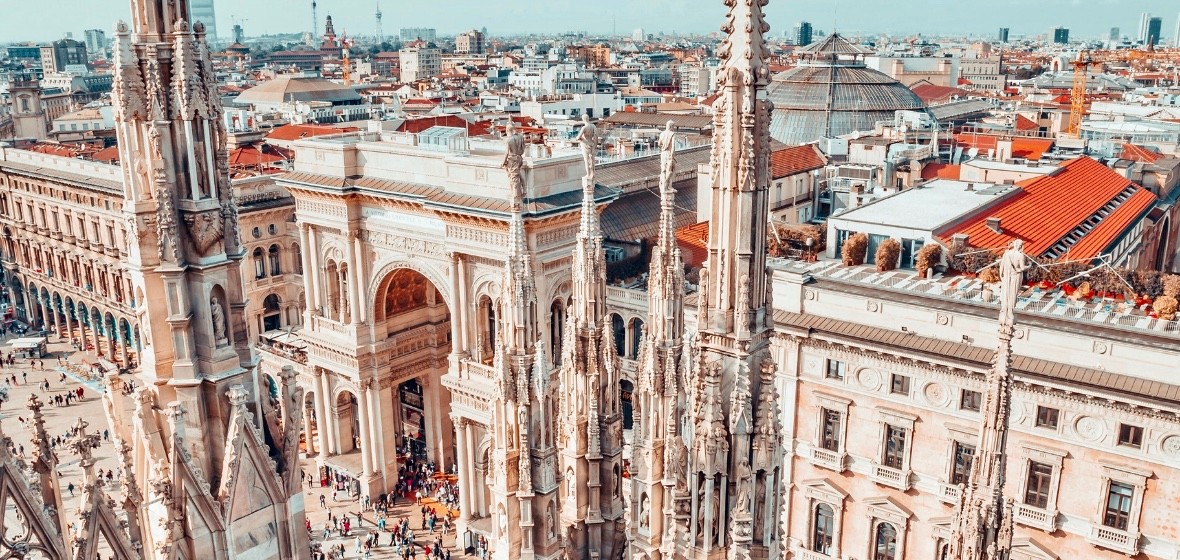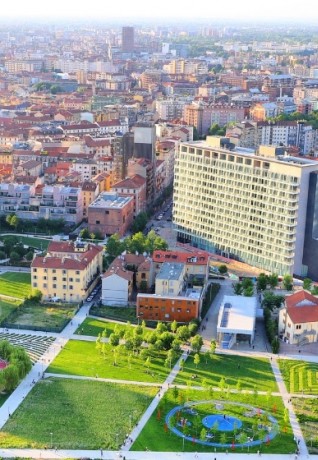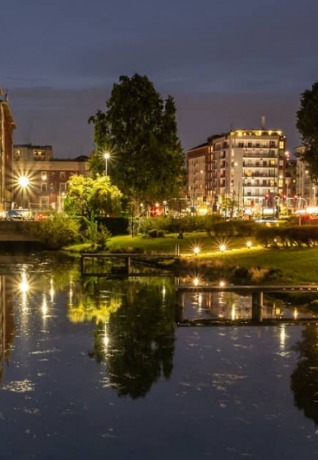MILANO: ITALY’S GATE TO EUROPE AND THE WORLD
With a population of 1.5 million (3 million with the metropolitan area), Milano is Italy's economic powerhouse and knowledge hub.
It’s also a city of art and culture, from the Duomo Cathedral to the Scala Opera House, from the Sforza Castle to the Brera Art Museum.
Easily connected to European and world capitals by high-speed trains and regular flights, Milano is renown around the world for fashion and design, and has been the financial and mercantile capital of Southern Europe since the Middle Ages.
Its fair, Fiera Milano, is a dominant player in international trade events for all key industries, while its banks are leading in fintech.
Half Latin, half Germanic, and 100% European since its early days as a feudal power, Milano/Milan/Mailand/米兰/ميلان has always been a cosmopolitan city, sitting at the intersection of many worlds: Northern/Southern Italy, Germany, Spain, Austria, France until modern times; today it's America, Japan, China, Russia and the Gulf that are attracted by Milano.
The city's economy and its businesses have long attracted workers and professionals from all over the world, while the city's international universities continue to churn out doctors, scientists, managers, engineers, architects, designers, stylists, editors, advertisers for the international economy.
On the eve of the pandemic, Milano was attracting 3.5 million tourists a year, surpassing the art capitals of Rome and Florence.
Milano is set to recover in the fall of 2021, when business tourists will start returning in large numbers for Salone del Mobile and Milano Design Week, which will be held in September this year.
Since 2015, when Milano hosted the world expo, the city has undergone a dramatic transformation, with two new skylines.
The current mayor, Giuseppe Sala, is working to make Milano greener, smarter, fairer.
Come and see for yourself!
The Duomo, the Galleria and Piazza della Scala are essentials of any trip to Milano, but you’ll be spending a lot of time walking along Corso Vittorio Emanuele, a bustling pedestrian and porticoed streed where all the stores of major global brands are located, in addition to movie theaters, department stores, media stores, and lots more.
Once you arrive at Piazza San Babila (M1 S. Babila), take a left and you’ll find the start of via Montenapoleone and the surrounding fashion district (M3 Montenapoleone). If you lose yourself in the internal streets, you’ll discover shops that sell clothes from fashion shows at discounted prices, often visited by fashionable eccentrics in search of new ideas: have fun trying on bizarre garments coming from Milano’s most daring fashionistas!
The Duomo is surrounded by many landmarks: Galleria Vittorio Emanuele II, Palazzo Reale the city’s most important exhibition venue, Museo del ‘900, a major collection of Italian Modernist paintings, La Rinascente, Milano’s historic department plus the surrounding shopping streets, displaying opportunities for every budget. And if you start feeling you need some food after all this, there are plenty of traditional and modern eateries around, whether you are looking for a Milanese risotto or a mouth-watering panzerotto.
The Duomo is Milano’s magnificent cathedral. Set in the exact center of the city, it is a late-Gothic masterpiece that remains etched in the memory of all those who visit Milano. As you exit the subway station, you can see it standing in front of you, topped by a golden statue of the Virgin Mary wearing the starred halo and carrying a spear: it is the beloved Madonnina, which gives Milano its anthem song and is often used to refer to the city itself (e.g. derby della madonnina to refer to the AC Milan – FC Inter Milan pitched fights on the soccer field). It took almost half a millennium for the Fabbrica del Duomo (the Duomo Factory, still in existence) to complete the second most important Italian church. Construction started in 1386, commissioned by the Duke of Milano Gian Galeazzo Visconti: the Duomo was meant as a symbol of the glory and grandeur of the city which was emerging as an Italian potentate at the time.
The Duomo is the largest Gothic building in the world. You will also find yourself looking upwards in awe at its countless spires, statues and gargoyles, which conjure the effect of a forest of marble. as it is the only church in the world that has sky-high statues on the pinnacles of its columns. Take the elevator in the back to the right of the façade to visit the roof terraces look at this masterpiece more closely. You’ll able to admire the whole panorama of the city and the Alps that rise from the plain in the distance.
To the left of the Duomo's elaborate façade, is Galleria Vittorio Emanuele II, the original shopping arcade inaugurating the liberty era, designed by architect Giuseppe Mengoni. Taking a stroll in the Galleria is a popular pastime and is a way of entering the heart of the city, since this splendid covered arcade links the Duomo to Teatro alla Scala. It immediately became a showcase for high-end shopkeepers, the place for a leisurely socializing walk and an aperitif or a relaxed dinner after the Opera.
La Scala is the most famous opera house in the world and an unmissable destination for melomaniacs and anybody who loves music and culture. Opera singers, dancers and directors made history here: Verdi and Puccini, Maria Callas and Pavarotti, Carla Fracci and Luchino Visconti have all trodden this hallowed stage. A Scala performance is a mesmerizing experience that goes way beyond the excellence presented on stage. The enchanted atmosphere, the acoustics, the prevalence of the sumptuous red and gold that are a trademark of the great theatres of the world: all adds up to a celebration of the power of music, an essential part of the history of Milano and the whole world. A very important moment marking the calendar of city life is the opening of the Scala opera season. Since 1951, it falls on December 7, day of St. Ambrose, Patron Saint of Milano.
CORSO VITTORIO EMANUELE
The Duomo, the Galleria and Piazza della Scala are essentials of any trip to Milano, but you’ll be spending a lot of time walking along Corso Vittorio Emanuele, a bustling pedestrian street with porticoes where all the stores of major global brands are located, in addition to movie theaters, department stores, media stores, and lots more. Once the Corse ends in Piazza San Babila (M1 S. Babila), take a left and you’ll find the start of via Montenapoleone and the surrounding fashion district (M3 Montenapoleone). If you lose yourself in the internal streets, you’ll discover shops that sell clothes from fashion shows at discounted prices, often visited by fashionable eccentrics in search of new ideas: have fun trying on bizarre garments coming from Milano’s most daring fashionistas!
THE SFORZA CASTLE (Castello Sforzesco)
The Sforza Castle is one of the largest manors in Europe. It was built by Francesco Sforza, a 15th century captain of venture who married into the ruling Visconti family and then seized power with a coup, overturning the short-lived Ambrosian Republic he had vowed to defend. For his ability and cunning, he was celebrated by Machiavelli in The Prince. At the end of the fifteenth century Leonardo da Vinci was engaged here, under the patronage of Ludovico il Moro, the last of the Sforza dukes, and, after extensive renovations, his Sala delle Asse is now open to the public and part Leonardo's itinerary. Today this imposing complex hosts Milano’s civic museums, which host the harrowing Pietà Rondanini, the timeless work of art that Michelangelo sculpted in his old age. The Castle’s grounds are captivating for the large courtyards, massive walls, moats, towers, bridges, leading to the green expanse of liberty-era Parco Sempione.
Milano is the location of one of most famous paintings of the world, the Last Supper by Leonardo da Vinci. The cenacolo vinciano is a UNESCO World Heritage site, and can be admired on the wall of the refectory of the church of Santa Maria delle Grazie (M1/M2 Cadorna FN). Celebrated by novels and movies, the Last Supper can only be rivalled by the Monna Lisa as the most beautiful painting of the world. Leonardo was engaged on the work from 1494 to 1497. The mural painting is extremely fragile and requires meticulous conservation: for this reason visits are limited and must be booked well in advance. Seeing the Last Supper is a must when visiting Milano.
Brera is the art district of Milano, which starts from Via Verdi right by the Scala theater.
You will find cobbled alleys, unique boutiques and historic shops, artistic bohemia and the same-name Pinacoteca which houses unique masterpieces of art in the world such as Hayez's Kiss, Mantegna's Dead Christ, Caravaggio's Supper at Emmaus, and Raffaello's Marriage of the Virgin.
Interesting and characteristic are the squares with cafes and dehors, and the brocantage market in Via Fiori Chiari every third Sunday of the month. Brera is place where you can experience nightlife on a human scale, discovering immortal works of art, and get perfect views for suggestive photos.
WHY GO THERE
To watch a modern play at the Strehler Theater, visit the Botanical Garden or study at the Academy of Fine Arts. In Brera you can also browse ancient and modern texts at the Braidense, one of Italy’s most important and beautiful librearies.
For a morning cappuccino or an evening beer, try Piazza del Carmine.
Other enjoyable landmarks include the deconsecrated Renaissance church of San Carpoforo or the peaceful beauty of the Basilica of San Simpliciano.
Neighborhood life revolves around via Moscova and via Solferino, especially at aperitif time. Piazza San Marco is where all the neiborhood’s streets converge, and has some the most popular restaurants and bars in Milan.
Leonardo’s water locks are nearby and Largo Treves is around the corner with its taxis and bicycles and a constant traffic of Milanese and tourists looking for an empty table at its busy cafés and eateries.
Corso Garibaldi starts from Via Tivoli near M2 Lanza and meanders through quaint shops and osterias, crowded bars and stores until it reaches the Porta Garibaldi Gate in Piazza XXV aprile, recently redesigned with movie theaters and high-quality food joints. It’s one of the most characteristic and attractive shopping streets of Milano and features the Renaissance architecture of the Church of the Coronation of Saint Mary with its characteristic double façade.
HOW TO GET THERE
Metro M3 Yellow Montenapoleone, M2 Green Lanza, Moscova
Walking around Via Montenapoleone is priceless: in an area of few block, you can find the most exclusive fashion streets in the world and be dazzled by the latest luxury trends and miracles of Italian craftsmanship.
The Fashion Quadrangle (Quadrilatero della moda) is Milano’s high-end shopping district, known all over the world. It is so named after the four stylish streets that define its boundaries: Via Montenapoleone, Via Manzoni, Via della Spiga and Corso Venezia, where all of international fashion & luxury brands have their stores, including those of Milanese fashion stylists. T
he district is criss-crossed by smaller cobblestone streets full of exquisite boutiques and luxury crafts.
The district is a shopping paradise for global visitors who come to the showrooms and boutiques to buy the latest dresses, suits and accessories, or just do window shopping, because fashion stores offer stunning compositions of taste and design in themselves.
Every year, in February and September (women's collections), January and June (men's collections) the Milano Fashion Week brings models and stylists on the catwalk for a phygital public made of actors, pop stars, influencers and fashion aficionados.
Milano's fashion shows capture the attention of the whole city and the global media, combining business and glamor, formal rigor and riotous excess. The area also lends itself to cultural tourism due to the many museums in the area, such as the historic Bagatti Valsecchi and Poldi Pezzoli art museums, and the Fashion and Costumes Museum at Palazzo Morando.
Possibly the coolest neighborhood in Milano, as this is where you can be free to be who you want to be.
Multiethnic and queer, Porta Venezia means culture, lifestyle, art, architecture.
Bordering the area, there is the first public park (1784) in the history of Milano (Giardini Indro Montanelli) with the Museum of Natural History and the Planetarium, the kids' merry-go-round, an outdoor bar where people play chess and that's only the beginning of it.
Just outside the park, there is the Modern Art Gallery - GAM, with its masterpieces of modern art, and the Pavillion of Contemporary Art - PAC, home to contemporary art installations.
The neighborhood hosts gems of Art Nouveau architecture, such as Casa Galimberti in Via Malpighi, and majestic neoclassical villas hosting gardens with pink flamingos (Palazzo Invernizzi) or the art deco beauty of Villa Necchi Campiglio (via Mozart).
HOW TO GET THERE
Metro M1 Red: Palestro, P.ta Venezia, Lima
Porta Venezia is near the center of Milano and is well-connected to the rest of the city by public transit. The Red line of the metro and the Passante suburban rail link both have stations at P.ta Venezia. For the Giardini of Porta Venezia, make sure you get off at Palestro, also on the M1 subway line.
WHY GO THERE
In October 2020, Porta Venezia was ranked among the forty coolest neighborhoods in the world by London's Time Out magazine.
The Porta Venezia district has a long and fascinating history. It became associated with modernity, architecture and shopping, during the age of art nouveau and futurism in the early 1900s.
Since the 1960s, it has been home of the large Eritrean and Ethiopian communities of Milano.
Since the 1990s, it has become the queer epicenter of the city, hosting the nation's largest LGBTQ Pride Parade every year.
For ethnic food, a drink, shopping or culture, you're likely to end up in Porta Venezia during your stay in Milano.
NoLo means North of Loreto, an emerging multicultural, creative neighborhood with a cool nightlife.
It has become a pole of attraction for young people, artists and designers, becoming one of the liveliest and most vibrant areas of the city.
Not to be missed: street art in Via Pontano, the green lung of Parco Trotter, Piazza Morbegno with its Art Nouveau fountain, buildings and cafés, Piazza Arcobalena, a square redesigned by tactical urbanism where you can rest or play table tennis, finally, the Viale Monza Covered Market, a 1930s art deco building with vegetable and fruit stalls, food delis, and a vocation for cultural events.
Nolo is well connected to the rest of the city (M1/M2 Loreto, M2 Caiazzo, M2/M3 Centrale), but the best way to get there is to take the tram #1 to Piazza Morbegno.

 Log in
Log in


